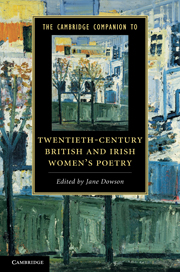Book contents
- Frontmatter
- 1 Introduction
- 2 Post/Modernist rhythms and voices: Edith Sitwell and Stevie Smith to Jo Shapcott and Selima Hill
- 3 Reframing women’s war poetry
- 4 Verbal and visual art in twentieth-century British women’s poetry
- 5 Towards a new confessionalism
- 6 The mid-Atlantic imagination: Mina Loy, Ruth Fainlight, Anne Stevenson, Anne Rouse and Eva Salzman
- 7 The Irish history wars and Irish women’s poetry: Eiléan Ní Chuilleanáin and Eavan Boland
- 8 Interculturalism: Imtiaz Dharker, Patience Agbabi, Jackie Kay and contemporary Irish poets
- 9 Post-pastoral perspectives on landscape and culture
- 10 Feminism’s experimental ‘work at the language-face’
- 11 Carol Ann Duffy, Medbh McGuckian and ruptures in the lines of communication
- Selected reading
- Index
5 - Towards a new confessionalism
Elizabeth Jennings and Sylvia Plath
Published online by Cambridge University Press: 28 May 2011
- Frontmatter
- 1 Introduction
- 2 Post/Modernist rhythms and voices: Edith Sitwell and Stevie Smith to Jo Shapcott and Selima Hill
- 3 Reframing women’s war poetry
- 4 Verbal and visual art in twentieth-century British women’s poetry
- 5 Towards a new confessionalism
- 6 The mid-Atlantic imagination: Mina Loy, Ruth Fainlight, Anne Stevenson, Anne Rouse and Eva Salzman
- 7 The Irish history wars and Irish women’s poetry: Eiléan Ní Chuilleanáin and Eavan Boland
- 8 Interculturalism: Imtiaz Dharker, Patience Agbabi, Jackie Kay and contemporary Irish poets
- 9 Post-pastoral perspectives on landscape and culture
- 10 Feminism’s experimental ‘work at the language-face’
- 11 Carol Ann Duffy, Medbh McGuckian and ruptures in the lines of communication
- Selected reading
- Index
Summary
In the current media climate – where columnists discuss their cancer and marital break-ups, memoir-writers explain their incestuous relationships and Springer guests say ‘Surprise, honey, I’m a man!’– poetry must at least stop disowning the original confessional movement, and instead celebrate how it made emotional exposure matter, and confronted us with uncomfortable truths. The confessional movement needs to be revalued as an important progression in twentieth-century poetry – one that was not just outpoured emotion, but emotion transformed into art by often ignored technical mastery.
In the article from which the above extract comes, ‘Getting Poetry to Confess’ (2001), the lyric poet Claire Pollard examines the enduring appeal of public exposure of private suffering and calls for a ‘New Confessionalism’ that will reclaim poetry’s potential readership. Pollard pinpoints the particular inhibitions for women:
It [Confessionalism] has also – via sectioned Anne and suicidal Sylvia – been attached to the image of woman as hysterical harpy: disturbed, hormonal, her own muse before she is an artist . . . To revert to a confessionalist mode now might be to reaffirm the cultural image of the ‘Mad Poetess’. After a period of great acclaim following her death, it was a notable fact that in Poetry Review’s 1994 ‘New Generation’ issue, none of the women poets cited Plath as an influence.
- Type
- Chapter
- Information
- Publisher: Cambridge University PressPrint publication year: 2011
- 1
- Cited by

